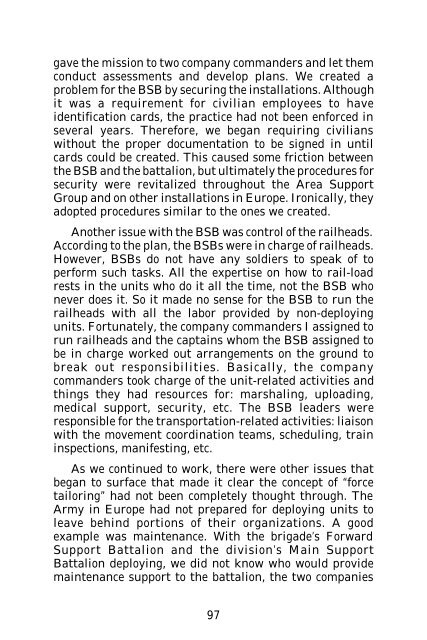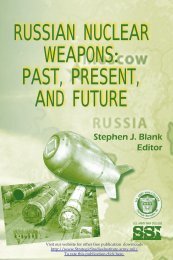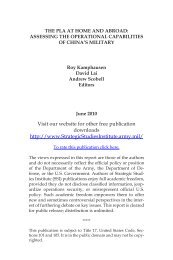Warriors in Peace Operations - Strategic Studies Institute - U.S. Army
Warriors in Peace Operations - Strategic Studies Institute - U.S. Army
Warriors in Peace Operations - Strategic Studies Institute - U.S. Army
You also want an ePaper? Increase the reach of your titles
YUMPU automatically turns print PDFs into web optimized ePapers that Google loves.
gave the mission to two company commanders and let them<br />
conduct assessments and develop plans. We created a<br />
problem for the BSB by secur<strong>in</strong>g the <strong>in</strong>stallations. Although<br />
it was a requirement for civilian employees to have<br />
identification cards, the practice had not been enforced <strong>in</strong><br />
several years. Therefore, we began requir<strong>in</strong>g civilians<br />
without the proper documentation to be signed <strong>in</strong> until<br />
cards could be created. This caused some friction between<br />
the BSB and the battalion, but ultimately the procedures for<br />
security were revitalized throughout the Area Support<br />
Group and on other <strong>in</strong>stallations <strong>in</strong> Europe. Ironically, they<br />
adopted procedures similar to the ones we created.<br />
Another issue with the BSB was control of the railheads.<br />
Accord<strong>in</strong>g to the plan, the BSBs were <strong>in</strong> charge of railheads.<br />
However, BSBs do not have any soldiers to speak of to<br />
perform such tasks. All the expertise on how to rail-load<br />
rests <strong>in</strong> the units who do it all the time, not the BSB who<br />
never does it. So it made no sense for the BSB to run the<br />
railheads with all the labor provided by non-deploy<strong>in</strong>g<br />
units. Fortunately, the company commanders I assigned to<br />
run railheads and the capta<strong>in</strong>s whom the BSB assigned to<br />
be <strong>in</strong> charge worked out arrangements on the ground to<br />
break out responsibilities. Basically, the company<br />
commanders took charge of the unit-related activities and<br />
th<strong>in</strong>gs they had resources for: marshal<strong>in</strong>g, upload<strong>in</strong>g,<br />
medical support, security, etc. The BSB leaders were<br />
responsible for the transportation-related activities: liaison<br />
with the movement coord<strong>in</strong>ation teams, schedul<strong>in</strong>g, tra<strong>in</strong><br />
<strong>in</strong>spections, manifest<strong>in</strong>g, etc.<br />
As we cont<strong>in</strong>ued to work, there were other issues that<br />
began to surface that made it clear the concept of “force<br />
tailor<strong>in</strong>g” had not been completely thought through. The<br />
<strong>Army</strong> <strong>in</strong> Europe had not prepared for deploy<strong>in</strong>g units to<br />
leave beh<strong>in</strong>d portions of their organizations. A good<br />
example was ma<strong>in</strong>tenance. With the brigade’s Forward<br />
Support Battalion and the division’s Ma<strong>in</strong> Support<br />
Battalion deploy<strong>in</strong>g, we did not know who would provide<br />
ma<strong>in</strong>tenance support to the battalion, the two companies<br />
97
















